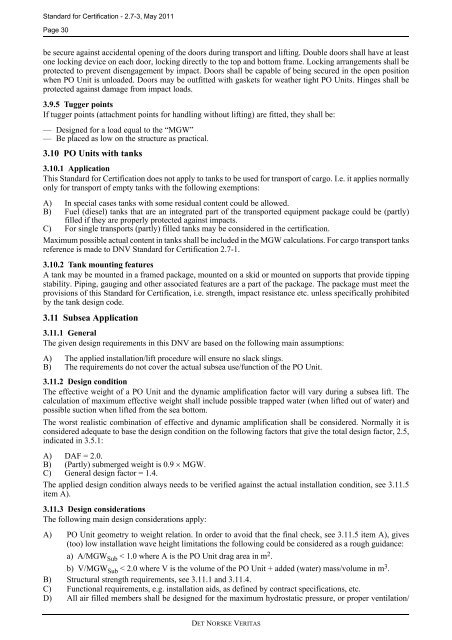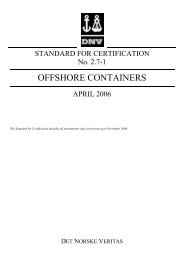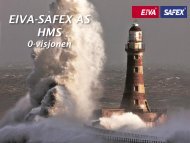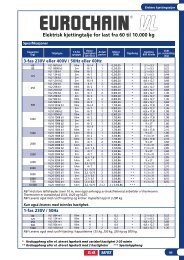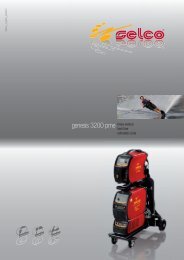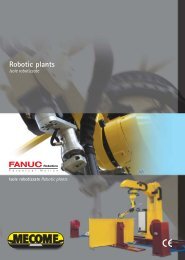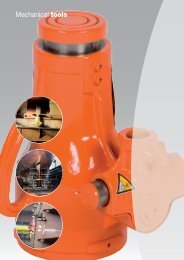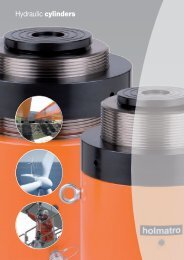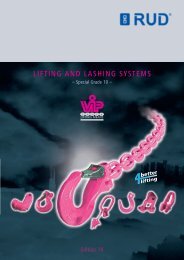<strong>Standard</strong> for Certification - 2.7-3, <strong>May</strong> 2011Page 30be secure against accidental opening of the doors during transport and lifting. Double doors shall have at leastone locking device on each door, locking directly to the top and bottom frame. Locking arrangements shall beprotected to prevent disengagement by impact. Doors shall be capable of being secured in the open positionwhen PO Unit is unloaded. Doors may be outfitted with gaskets for weather tight PO Units. Hinges shall beprotected against damage from impact loads.3.9.5 Tugger pointsIf tugger points (attachment points for handling without lifting) are fitted, they shall be:— Designed for a load equal to the “MGW”— Be placed as low on the structure as practical.3.10 PO Units with tanks3.10.1 ApplicationThis <strong>Standard</strong> for Certification does not apply to tanks to be used for transport of cargo. I.e. it applies normallyonly for transport of empty tanks with the following exemptions:A) In special cases tanks with some residual content could be allowed.B) Fuel (diesel) tanks that are an integrated part of the transported equipment package could be (partly)filled if they are properly protected against impacts.C) For single transports (partly) filled tanks may be considered in the certification.Maximum possible actual content in tanks shall be included in the MGW calculations. For cargo transport tanksreference is made to <strong>DNV</strong> <strong>Standard</strong> for Certification 2.7-1.3.10.2 Tank mounting featuresA tank may be mounted in a framed package, mounted on a skid or mounted on supports that provide tippingstability. Piping, gauging and other associated features are a part of the package. The package must meet theprovisions of this <strong>Standard</strong> for Certification, i.e. strength, impact resistance etc. unless specifically prohibitedby the tank design code.3.11 Subsea Application3.11.1 GeneralThe given design requirements in this <strong>DNV</strong> are based on the following main assumptions:A) The applied installation/lift procedure will ensure no slack slings.B) The requirements do not cover the actual subsea use/function of the PO Unit.3.11.2 Design conditionThe effective weight of a PO Unit and the dynamic amplification factor will vary during a subsea lift. Thecalculation of maximum effective weight shall include possible trapped water (when lifted out of water) andpossible suction when lifted from the sea bottom.The worst realistic combination of effective and dynamic amplification shall be considered. Normally it isconsidered adequate to base the design condition on the following factors that give the total design factor, 2.5,indicated in 3.5.1:A) DAF = 2.0.B) (Partly) submerged weight is 0.9 MGW.C) General design factor = 1.4.The applied design condition always needs to be verified against the actual installation condition, see 3.11.5item A).3.11.3 Design considerationsThe following main design considerations apply:A) PO Unit geometry to weight relation. In order to avoid that the final check, see 3.11.5 item A), gives(too) low installation wave height limitations the following could be considered as a rough guidance:a) A/MGW Sub < 1.0 where A is the PO Unit drag area in m 2 .b) V/MGW Sub < 2.0 where V is the volume of the PO Unit + added (water) mass/volume in m 3 .B) Structural strength requirements, see 3.11.1 and 3.11.4.C) Functional requirements, e.g. installation aids, as defined by contract specifications, etc.D) All air filled members shall be designed for the maximum hydrostatic pressure, or proper ventilation/DET NORSKE VERITAS
<strong>Standard</strong> for Certification - 2.7-3, <strong>May</strong> 2011Page 31water filling shall be ensured.E) Lift points below CoG should normally be avoided.F) Proper draining when lifted out of the water (if applicable).G) Lift points should be placed/designed in such a way that the risk of damage and/or accidental release ofsling set are neglectable.H) Extended (more than a few days) subsea application of PO Units should be specially evaluated and shallnot be considered covered by the given requirements in this standard.3.11.4 Other design loadsIn addition to the basic lift load case, see 3.5 and 3.11.1, the following need to be considered, if applicable:A) Effect of horizontal wave loads. The tilt effect of this on the PO Unit could normally be consideredcovered by the requirements in 3.5.B) Local design for hydrodynamic loads, e.g. slamming loads.C) Tugger points for horizontal and rotational control.D) Guiding system for final positioning.E) Retrieval loads.F) Hydrostatic pressure, see 3.11.3 D).3.11.5 Operational aspectsAll assumed operational limitations shall be clearly indicated in the PO Units design documentation. Criticallimitations should be indicated in the certificate and normally marked on the PO Unit. Such limitations couldbe:A) Installation wave height/periods (if evaluated/applicable). The installation contractor needs to do a finalassessment of the applicable operation limitations based on the actual installation vessel and –procedure.B) Special considerations, e.g. the PO Unit should pass splash zone with inclination.C) Maximum allowable water depth.D) Maximum allowable loads on tugger points and guiding systems.E) Acceptable sling angles (range).Installation means on the PO Unit, e.g. as marking, ROV grab bars, tag/tugger line connection points, skids formonitoring systems/equipment, should be installed as agreed.4. Manufacture4.1 GeneralManufacture shall be performed according to approved drawings, specifications and procedures.The manufacturer should present a quality plan for acceptance before production starts. Relevant productiondocuments (ref. Section 4.4) should also be presented for acceptance before start of production.Materials and fabrication processes used for the primary structure shall be identified with the requireddocumentation during fabrication and on the finished product.4.2 MaterialsMetals utilized in primary structures shall as a minimum be supplied with a “Works Certificate” equivalent toan Inspection Certificate of type 3.1 as defined in EN10204.During production, and on the finished product, it shall be possible to identify the materials used for the primarystructure with the corresponding documentation. If the marking is not visible on the finished product, a log shallbe kept of the components to identify and ensure traceability of the materials.4.3 WeldingWelders and welding procedures shall be approved by <strong>DNV</strong> and shall be according to a recognised standard,e.g. <strong>DNV</strong>-OS-C401, ASME section IX, ANSI/ AWS D1.1, EN 287 and EN288 or JIS.Where approval of welding procedures and certification of welders is performed by other independentorganisations, e.g. accredited or nationally approved certification bodies, recognition of such certification willbe evaluated on a case by case basis. <strong>DNV</strong> reserves the right, however, to require verification of the approvalwhen deemed necessary. Such verification may include additional NDT and/or welding tests.Welding procedure specifications, welding procedure qualification tests and approval of welding proceduresshall be in accordance with a recognised standard, e.g. ASME section IX, ANSI/ AWS D1.1, EN 287 andEN288 or JIS.Welding procedures for base materials not listed in the above standards shall be qualified individually or as aDET NORSKE VERITAS
- Page 1 and 2: STANDARD FOR CERTIFICATIONNo. 2.7-3
- Page 5 and 6: Standard for Certification - 2.7-3,
- Page 7 and 8: Standard for Certification - 2.7-3,
- Page 9 and 10: Standard for Certification - 2.7-3,
- Page 11 and 12: Standard for Certification - 2.7-3,
- Page 13 and 14: Standard for Certification - 2.7-3,
- Page 15 and 16: Standard for Certification - 2.7-3,
- Page 17 and 18: Standard for Certification - 2.7-3,
- Page 19 and 20: Standard for Certification - 2.7-3,
- Page 21 and 22: Standard for Certification - 2.7-3,
- Page 23 and 24: Standard for Certification - 2.7-3,
- Page 25 and 26: Standard for Certification - 2.7-3,
- Page 27 and 28: Standard for Certification - 2.7-3,
- Page 29: Standard for Certification - 2.7-3,
- Page 33 and 34: Standard for Certification - 2.7-3,
- Page 35 and 36: Standard for Certification - 2.7-3,
- Page 37 and 38: Standard for Certification - 2.7-3,
- Page 39 and 40: Standard for Certification - 2.7-3,
- Page 41 and 42: Standard for Certification - 2.7-3,
- Page 43 and 44: Standard for Certification - 2.7-3,
- Page 45: Standard for Certification - 2.7-3,


